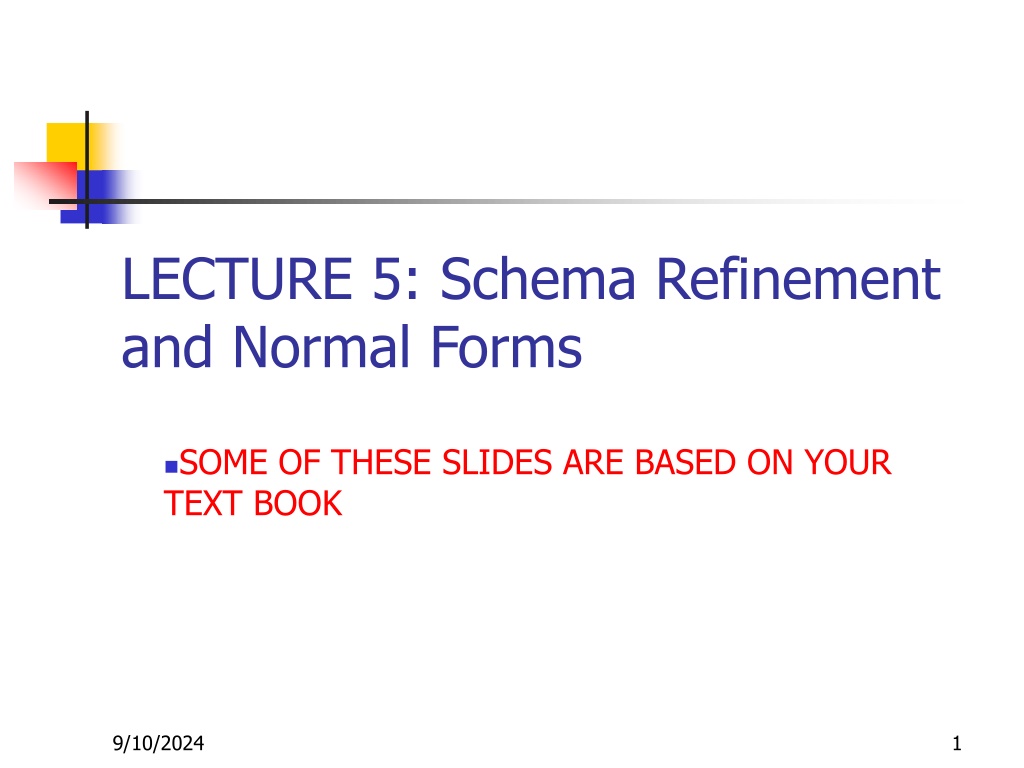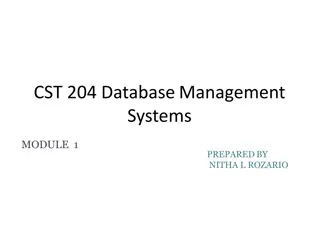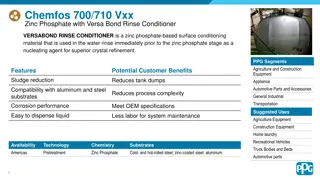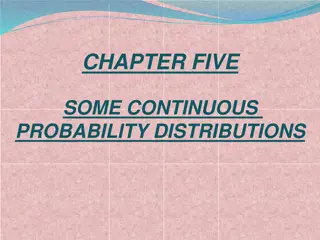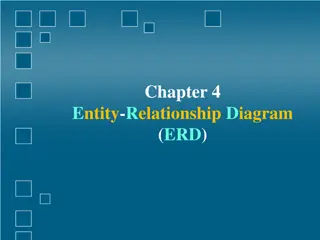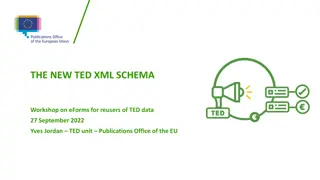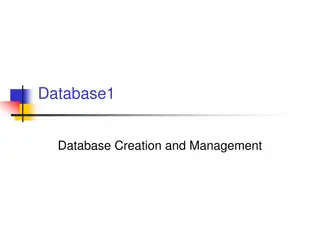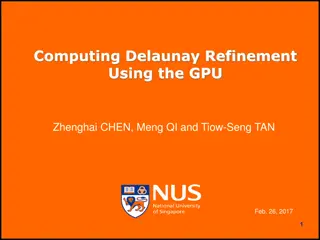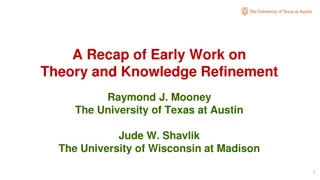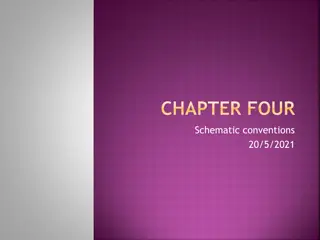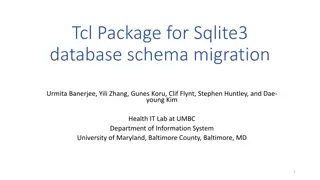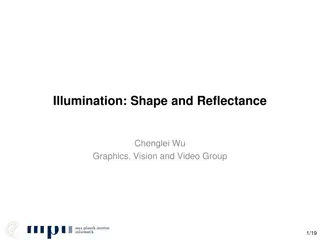Database Schema Refinement and Normal Forms Explained
Explore the concept of schema refinement and normal forms in database management. Understand issues like insertion, deletion, and update anomalies in database tables. Learn about set-valued attributes and their implications in designing databases for tracking customer transactions.
Download Presentation

Please find below an Image/Link to download the presentation.
The content on the website is provided AS IS for your information and personal use only. It may not be sold, licensed, or shared on other websites without obtaining consent from the author.If you encounter any issues during the download, it is possible that the publisher has removed the file from their server.
You are allowed to download the files provided on this website for personal or commercial use, subject to the condition that they are used lawfully. All files are the property of their respective owners.
The content on the website is provided AS IS for your information and personal use only. It may not be sold, licensed, or shared on other websites without obtaining consent from the author.
E N D
Presentation Transcript
LECTURE 5: Schema Refinement and Normal Forms SOME OF THESE SLIDES ARE BASED ON YOUR TEXT BOOK 9/10/2024 1
title year length filmType studioName starName Star Wars 1977 124 color Fox Carrie Fisher Star Wars 1977 124 color Fox Mark Haill Star Wars 1977 124 color Fox Harrison Ford Mighty Ducks 1991 104 color Disney Emilo Estevez Wayne s World 1992 95 color Paramount Dana Carvey Wayne s World 1992 95 color Paramount Mike Meyers Anomalies Insertion anomalies Cannot record filmType without starName Deletion anomalies If we delete the last star, we also lose the movie info. Modification (update) anomalies
DECOMPOSITION title year length filmType studioName starName Star Wars 1977 124 color Fox Carrie Fisher Star Wars 1977 124 color Fox Mark Haill Star Wars 1977 124 color Fox Harrison Ford Mighty Ducks 1991 104 color Disney Emilo Estevez Wayne s World 1992 95 color Paramount Dana Carvey Wayne s World 1992 95 color Paramount Mike Meyers title year starName Star Wars 1977 Carrie Fisher title year length filmType studioName Star Wars 1977 Mark Haill Star Wars 1977 124 color Fox Star Wars 1977 Harrison Ford Mighty Ducks 1991 104 color Disney Mighty Ducks 1991 Emilo Estevez Wayne s World 1992 95 color Paramount Wayne s World 1992 Dana Carvey Wayne s World 1992 Mike Meyers
Is there a possibility of an update, deletion, and insertiona anomalies in the table below? Explain with examples StudentNum CourseNum Student Name Address Course S21 9201 Jones Edinburgh Accounts 1 S21 9267 Jones Edinburgh physics S24 9267 Smith Glasgow physics S30 9201 Richards Manchester Accounts 1 S30 9322 Richards Manchester Maths 9/10/2024 4
Set valued attributes: example Consider a database of customer transactions You have customers represented by cid, and transactions represented by tid, where each transaction has multiple items, represented by itemid, together with name, quantity and the cost of the item Design a database to keep track of the transactions of customers (set valued, vs flat design) Example queries: what is the total sales in dollars per item What is the total sales per customer 9/10/2024 5
Schema Refinement functional dependencies, can be used to identify schemas with problems and to suggest refinements. Decomposition is used for schema refinement. 9/10/2024 6
Example FD Database of beer drinkers BEER LIKED FAV BEER NAME ADDR MANUF John Doe NY, Soho Bud Light BW Leffe John Doe NY, Soho Leffe LF Leffe Elisa Day DC, Dupont Gusto Weiss Gusto Chimay Blue Elisa Day DC, Dupont Chimay Blue Chimay Chimay Blue
Example FD title year length title year filmType title year studioName title year length filmType studioName TITLE YEAR LENGTH FILMTYPE studioName starName Star Wars 1977 124 color Fox Carrie Fisher Star Wars 1977 124 color Fox Mark Hamill Star Wars 1977 124 color Fox Harrison Ford Mighty Ducks 1991 104 color Disney Emilio Estevez Wayne s World 1992 95 color Paramount Dana Carvey Wayne s World 1992 95 color Paramount Mike Meyers
Functional Dependencies (FDs) A functional dependency X Y holds over relation R if, for every allowable instance r of R: t1 r, t2 r, (t1) = (t2) implies (t1) = (t2) i.e., given two tuples in r, if the X values agree, then the Y values must also agree. (X and Y are sets of attributes.) X Y Y X X 1 2 1 2 Y a b a b Z p q r p t1 t2
Functional Dependencies (FDs) Does the following relation instance satisfy X->Y ? X 1 2 1 2 Y a b a c Z p q r p
Functional Dependencies (FDs) A functional dependency X Y holds over relation R if, for every allowable instance r of R: t1 r, t2 r, (t1) = (t2) implies (t1) = (t2) i.e., given two tuples in r, if the X values agree, then the Y values must also agree. (X and Y are sets of attributes.) An FD is a statement about all allowable relations. Must be identified based on semantics of application. Given some allowable instance r1 of R, we can check if it violates some FD f, but we cannot tell if f holds over R! K is a candidate key for R means that K R However, K R does not require K to be minimal! X Y Y X
Functional Dependencies (FDs) Does the following relation instance satisfy X->Y ? X 1 2 1 3 Y a b a b Z p q r p 9/10/2024 12
Functional Dependencies (FDs) If X is a candidate key, then X -> Y Z ! X 1 2 1 3 Y a b a b Z p q r p 9/10/2024 13
Functional Dependencies (FDs) If Y Z -> X can we say YZ is a candidate key? X 1 2 1 3 Y a b a b Z p q r p 9/10/2024 14
Example: Constraints on Entity Set Consider relation obtained from Hourly_Emps: Hourly_Emps (ssn, name, lot, rating, hrly_wages, hrs_worked) Notation: We will denote this relation schema by listing the attributes: SNLRWH This is really the set of attributes {S,N,L,R,W,H}. Sometimes, we will refer to all attributes of a relation by using the relation name. (e.g., Hourly_Emps for SNLRWH) S N L R W H Hourly_Emps
Example: Constraints on Entity Set Some FDs on Hourly_Emps: ssn is the key: S SNLRWH rating determines hrly_wages: R W Did you notice anything wrong with the following instance ? S N L R 1 2 3 2 W 100 200 250 300 H
Example: Constraints on Entity Set Some FDs on Hourly_Emps: ssn is the key: S SNLRWH rating determines hrly_wages: R W Salary should be the same for a given rating! S N L R 1 2 3 2 W 100 200 250 200 H
S 123-22-3666 Attishoo 231-31-5368 Smiley 131-24-3650 Smethurst 35 5 7 434-26-3751 Guldu 612-67-4134 Madayan N L 48 8 10 40 22 8 10 30 R W H Example 30 32 35 5 7 35 8 10 40 Problems due to R W : Update anomaly: Can we change W in just the 1st tuple of SNLRWH? Insertion anomaly: What if we want to insert an employee and don t know the hourly wage for his rating? Deletion anomaly: If we delete all employees with rating 5, we lose the information about the wage for rating 5!
S 123-22-3666 Attishoo 231-31-5368 Smiley 131-24-3650 Smethurst 35 5 7 434-26-3751 Guldu 612-67-4134 Madayan N L 48 8 10 40 22 8 10 30 R W H Hourly_Emps 30 32 35 5 7 35 8 10 40 Hourly_Emps2 Wages S 123-22-3666 Attishoo 231-31-5368 Smiley 131-24-3650 Smethurst 35 5 30 434-26-3751 Guldu 612-67-4134 Madayan N L 48 8 40 22 8 30 R H R W 8 10 5 7 35 5 32 35 8 40
Refining an ER Diagram 1st diagram translated: Workers(S,N,L,D,S) Departments(D,M,B) Lots associated with workers. Suppose all workers in a dept are assigned the same lot: D L since name dname ssn lot did budget Works_In Employees Departments
Refining an ER Diagram Suppose all workers in a dept are assigned the same lot: D L Redundancy; fixed by: Workers2(S,N,D,S) Dept_Lots(D,L) Can fine-tune this: Workers2(S,N,D,S) Departments(D,M,B,L) budget since name dname ssn did lot Works_In Employees Departments
Reasoning About FDs Given some FDs, we can usually infer additional FDs: ssn did, did lot implies ssn lot An FD f is implied by a set of FDs F if f holds whenever all FDs in F hold. = closure of F is the set of all FDs that are implied by F. Armstrong s Axioms (X, Y, Z are sets of attributes): Reflexivity: If X Y, then Y X (a trivial FD) Augmentation: If X Y, then XZ YZ for any Z Transitivity: If X Y and Y Z, then X Z These are sound and complete inference rules for FDs! F+
Reasoning About FDs S N L R W H For example, in the above schema S N -> S is a trivial FD since {S,N} is a superset of {S}
Reasoning About FDs S N L R W H For example, in the above schema If S N -> R W, then S N L -> R W L (by augmentation)
Reasoning About FDs (Contd.) Couple of additional rules (that follow from AA): Union: If X -> Y and X -> Z, then X -> YZ Proof: From X -> Y, we have XX -> XY (by augmentation) Note that XX is X, therefore X -> XY From X -> Z, we have XY -> YZ (by augmentation) From X -> XY and XY -> YZ, we have X -> YZ (by transitiviy)
Reasoning About FDs (Contd.) Couple of additional rules (that follow from AA): Decomposition: If X -> YZ, then X -> Y and X -> Z Try to prove it at home/dorm/IC/Vitamin/DD/Bus!
Reasoning About FDs (Contd.) Example: Contracts(cid,sid,jid,did,pid,qty,value), and: C is the key: C CSJDPQV Project purchases each part using single contract: JP C Dept purchases at most one part from a supplier: SD P JP C, C CSJDPQV imply JP CSJDPQV SD P implies SDJ JP SDJ JP, JP CSJDPQV imply SDJ CSJDPQV
Reasoning About FDs (Contd.) F+ Computing the closure of a set of FDs ( ) can be expensive. (Size of closure is exponential in # attrs!) Example: A database with 3 attributes (A,B,C) F = {A->B, B->C} Find the closure of F denoted by F+
Example Suppose we are given a relation scheme R = (A,B,C,G,H,I), and the set of functional dependencies, F provided below: A B A C CG H CG I B H Is A H logically implied by F? Is AG I logically implied by F? 9/10/2024 29
Reasoning About FDs (Contd.) F+ Computing the closure of a set of FDs ( ) can be expensive. (Size of closure is exponential in # attrs!) Typically, we just want to check if a given FD X Y is in the closure of a set of FDs F. An efficient check: Compute attribute closure of X (denoted ) wrt F: Set of all attributes A such that X A is in There is a linear time algorithm to compute this. For each FD Y -> Z in F, if is a superset of Y then add Y to X+ F+ X+ X+
Reasoning About FDs (Contd.) Does F = {A B, B C, C D E } imply A E? i.e, is A E in the closure ? Equivalently, is E in ? F+ A+ Lets compute A+ Initialize A+ to {A} : A+ = {A} From A -> B, we can add B to A+ : A+ = {A, B} From B -> C, we can add C to A+ : A+ = {A, B, C} We can not add any more attributes, and A+ does not contain E therefore A -> E does not hold.
DB Design Guidelines Design a relation schema with a clearly defined semantics Design the relation schemas so that there is not insertion, deletion, or modification anomalies. If there may be anomalies, state them clearly Avoid attributes which may frequently have null values as much as possible. Make sure that relations can be combined by key- foreign key links 9/10/2024 32
Normal Forms Normal forms are standards for a good DB schema (introduced by Codd in 1972) If a relation is in a certain normal form (such as BCNF, 3NF etc.), it is known that certain kinds of problems are avoided/minimized. Normal forms help us decide if decomposing a relation helps.
Normal Forms First Normal Form: No set valued attributes (only atomic values) sid 1 name ali phones {5332344568, 2165533561} 2 3 4 veli ayse fatma
Normal Forms (Contd.) Role of FDs in detecting redundancy: Consider a relation R with 3 attributes, ABC. No FDs hold: There is no redundancy here. Given A -> B: Several tuples could have the same A value, and if so, they ll all have the same B value!
Normal Forms (Contd.) Second Normal Form : Every non-prime attribute should be fully functionally dependent on every key (i.e., candidate keys). In other words: No non-prime attribute in the table is functionally dependent on a proper subset of any candidate key Prime attribute: any attribute that is part of a key Non-prime attributes: rest of the attributes Ex: If AB is a key, and C is a non-prime attribute, then if A->C holds then A partially determines C (there is a partial functional dependency to a key)
Third Normal Form (3NF) F+ Reln R with FDs F is in 3NF if, for all X A in A X (called a trivial FD), or X contains a key for R, or A is part of some key for R. If R is in 3NF, some redundancy is possible.
What Does 3NF Achieve? If 3NF violated by X -> A, one of the following holds: X is a subset of some key K We store (X, A) pairs redundantly. X is not a proper subset of any key. There is a chain of FDs K -> X -> A, which means that we cannot associate an X value with a K value unless we also associate an A value with an X value. But: even if reln is in 3NF, these problems could arise. e.g., Reserves SBDC, S C, C S is in 3NF, but for each reservation of sailor S, same (S, C) pair is stored. There is a stricter normal form (BCNF).
Boyce-Codd Normal Form (BCNF) F+ Reln R with FDs F is in BCNF if, for all X A in A X (called a trivial FD), or X contains a key for R. (i.e., X is a superkey) In other words, R is in BCNF if the only non-trivial FDs that hold over R are key constraints. No dependency in R that can be predicted using FDs alone. If we are shown two tuples that agree upon the X value, we cannot infer the A value in one tuple from the A value in the other. If example relation is in BCNF, the 2 tuples must be identical (since X is a key). X Y x x A y1 a y2 ?
Normal Forms Contd. Person(SSN, Name, Address, Hobby) F = {SSN Hobby -> Name Address, SSN ->Name Address} SSN Name Address Hobby 111111 Celalettin Sabanci D. Stamps 111111 Celalettin Sabanci D. Coins 555555 Elif Mutlukent Skating 555555 Elif Mutlukent Surfing 666666 Sercan Esentepe Math Is the above relation in 2nd normal form ? 9/10/2024 40
Normal Forms Contd. Ex: R = ABCD, F={AB->CD, AC->BD} What are the (candidate) keys for R? Is R in 3NF? Is R in BCNF? A 1 2 B 1 1 C 3 3 D 4 4 Is there a redundancy in the above instance With respect to F ? 9/10/2024 41
Example An employee can be assigned to at most one project, but many employees participate in a project EMP_PROJ(ENAME, SSN, ADDRESS, PNUMBER, PNAME, PMGRSSN) PMGRSSN is the SSN of the manager of the project Is this a good design? 9/10/2024 42
Decomposition of a Relation Scheme Suppose that relation R contains attributes A1 ... An. A decomposition of R consists of replacing R by two or more relations such that: Each new relation scheme contains a subset of the attributes of R (and no attributes that do not appear in R), and Every attribute of R appears as an attribute of one of the new relations. Intuitively, decomposing R means we will store instances of the relation schemes produced by the decomposition, instead of instances of R. E.g., Can decompose SNLRWH into SNLRH and RW.
Decomposition of a Relation Scheme We can decompose SNLRWH into SNL and RWH. S N L R W H S N L R W H
Example Decomposition SNLRWH has FDs S -> SNLRWH and R -> W Is this in 3NF? R->W violates 3NF (W values repeatedly associated with R values) In order to fix the problem, we need to create a relation RW to store the R->W associations, and to remove W from the main schema: i.e., we decompose SNLRWH into SNLRH and RW S N L R H R W
Problems with Decompositions There are potential problems to consider: Some queries become more expensive. e.g., How much did Ali earn ? (salary = W*H) S N L R H R W
Problems with Decompositions Given instances of the decomposed relations, we may not be able to reconstruct the corresponding instance of the original relation!
Lossless Join Decompositions Decomposition of R into X and Y is lossless-join w.r.t. a set of FDs F if, for every instance r that satisfies F: (r) (r) = r It is always true that r (r) (r) In general, the other direction does not hold! If it does, the decomposition is lossless-join. Definition extended to decomposition into 3 or more relations in a straightforward way. It is essential that all decompositions used to deal with redundancy be lossless! (Avoids Problem (2).) X Y X Y
A B 1 4 7 More on Lossless Join 2 5 2 A B C 1 2 4 5 7 2 The decomposition of R into X and Y is lossless-join wrt F if and only if the closure of F contains: X Y X, or X Y Y In particular, the decomposition of R into UV and R - V is lossless-join if U V holds over R. 3 6 8 B 2 5 2 C 3 6 8 A B C 1 2 4 5 7 2 1 2 7 2 3 6 8 8 3
Person(SSN, Name, Address, Hobby) F = {SSN Hobby -> Name Address, SSN ->Name Address} Person SSN Name Address Hobby 111111 Celalettin Sabanci D. Stamps 111111 Celalettin Sabanci D. Coins 555555 Elif Mutlukent Skating 555555 Elif Mutlukent Surfing 666666 Sercan Esentepe Math Person1 Hobby SSN Name Address SSN Hobby 111111 Celalettin Sabanci D. 111111 Stamps 555555 Elif Mutlukent 111111 Coins 666666 Sercan Esentepe 555555 Skating 555555 Surfing 666666 Math
